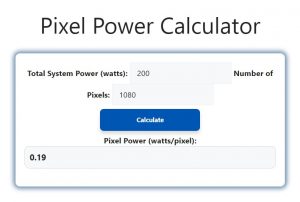About Pixel Power Calculator (Formula)
The Pixel Power Calculator is an essential tool for anyone working with display systems, such as monitors, TVs, or LED screens. It helps determine the power consumption per pixel, enabling users to optimize performance and energy efficiency. Understanding pixel power is crucial for designers, engineers, and users who aim to manage energy costs and enhance the functionality of their devices. By utilizing this calculator, you can gain insights into how power is distributed across the pixels in your display system.
Formula
The formula for calculating Pixel Power (PP) is:
Pixel Power (PP) = Total System Power (TP) / Number of Pixels (P).
How to Use
- Determine Total System Power (TP): Find the total power consumption of your display system, usually provided in watts (W).
- Count the Number of Pixels (P): Determine the total number of pixels in your display. This is typically calculated by multiplying the width and height of the display in pixels.
- Input Values: Plug the values of TP and P into the formula to calculate Pixel Power (PP).
- Interpret the Result: The resulting value will give you the power consumption per pixel, indicating how much energy each pixel requires to function.
Example
Let’s consider a display system that consumes a total power of 200 watts and has a resolution of 1920 x 1080 pixels.
- Total System Power (TP): 200 W.
- Number of Pixels (P): 1920 * 1080 = 2,073,600 pixels.
- Calculate Pixel Power (PP):
PP = 200 W / 2,073,600 pixels
PP = 0.0000965 W or 96.5 µW (micro-watts) per pixel.
This means each pixel in this display system consumes approximately 96.5 micro-watts of power.

FAQs
- What is Pixel Power?
Pixel Power refers to the amount of power consumed by each pixel in a display system. - Why is it important to calculate Pixel Power?
Calculating Pixel Power helps optimize energy consumption, manage costs, and improve the efficiency of display systems. - How do I find the Total System Power (TP)?
The Total System Power is usually specified in the device’s technical specifications or can be measured using a power meter. - What units are used for Pixel Power?
Pixel Power is typically measured in watts (W) or micro-watts (µW). - Can I use the Pixel Power Calculator for any display type?
Yes, it can be used for various display types, including LCD, LED, and OLED screens. - Does the Pixel Power affect the quality of the display?
While Pixel Power itself doesn’t directly impact display quality, efficient power management can enhance performance and longevity. - How can I reduce Pixel Power consumption?
You can reduce Pixel Power by optimizing brightness settings, using energy-efficient components, and managing display resolutions. - Is there a maximum Pixel Power that is considered safe?
There is no specific maximum Pixel Power; however, excessive power consumption can lead to overheating and reduced lifespan of the display. - How does resolution impact Pixel Power?
Higher resolutions increase the number of pixels, which can lead to lower Pixel Power per pixel if the total power remains constant. - What happens if I increase the brightness of my display?
Increasing brightness typically raises the Total System Power, potentially increasing the Pixel Power as well. - Can I apply this calculator to mobile devices?
Yes, the Pixel Power Calculator can be applied to any device with a display that has a specified total power consumption and pixel count. - What if I don’t know the Total System Power?
If you don’t know the Total System Power, consider using a power meter to measure the actual consumption while the device is operating. - How often should I check Pixel Power?
It’s good practice to check Pixel Power periodically, especially when making changes to display settings or hardware. - What other factors affect power consumption in displays?
Factors such as refresh rate, color settings, and display technology can also impact overall power consumption. - Is the Pixel Power Calculator useful for designing new displays?
Yes, it can help in the design phase to estimate energy consumption and make informed decisions on components and configurations. - Does Pixel Power influence battery life in portable devices?
Yes, higher Pixel Power can lead to increased battery drain in mobile devices, affecting overall battery life. - Can I use this calculator for 3D displays?
The calculator can be used for 3D displays, but the total power consumption may vary based on additional processing requirements. - Are there any software tools available for monitoring Pixel Power?
Yes, there are various software tools and applications that can help monitor power consumption and performance metrics in displays. - What is the typical Pixel Power range for modern displays?
Pixel Power can vary significantly, but modern displays often range from a few micro-watts to several milliwatts per pixel. - How does Pixel Power relate to energy efficiency ratings?
Lower Pixel Power can contribute to better energy efficiency ratings, making displays more attractive for eco-conscious consumers.
Conclusion
The Pixel Power Calculator is a valuable tool for understanding and optimizing the power consumption of display systems. By calculating the power consumed per pixel, users can make informed decisions that enhance energy efficiency and performance. Whether you’re an engineer, designer, or tech enthusiast, knowing how to use this calculator will help you manage energy costs and improve the sustainability of your display technologies.